Are you a tea lover? If your answer is “yes”, you can’t miss our 13 days China Green Tea Tour! As the birthplace of tea, China attracts many tea lovers every year to learn and disseminate its tea culture. During this tour, you can truly learn the histories of many kinds of Chinese tea, visit their producing area, and you will also have the chance to experience to make a cup of tea by yourself. You will go to the teahouse that Queen Elizabeth II of the United Kingdom ever visited, watch tea ceremonies, and visit tea plantations. Especially in Mount Wuyi in Fujian Province of China, you will have a wonderful Chinese Black Tea Tour. During the Wuyishan Tea Tour, you will visit the famous Tea Cave, appreciate the first tree of Mount Wuyi Tea, listen to the ancient stories of Dahongpao Tea, and feel the long history of Chinese tea. Don’t hesitate! Join us now!

Welcome to Shanghai! Shanghai is a world-known city, covering an area of 6,340 square kilometers and having a population of over 24 million. Shanghai is also called the “Magic Capital” and “the Paris of the East”. Upon your arrival, the guide will meet you at the exit of the airport and escort you to the hotel for a rest.
After having breakfast, your 13-day China Green Tea Tour will start at Yu Garden (closed on Mondays). As a classical garden in south China, it was built in the Ming Dynasty (1368 - 1644) and covers an area of more than 20,000 square meters. It was originally a private garden. What we can see today is the essence after some repair works. Here you can see magnificent and exquisite sceneries, including the Ancient Stage, the stone peaks of Yu Ling Long, brick carvings and clay sculptures.
To the southwest of Yu Garden is the Mid-lake Pavilion. It is located in the middle of a lake and is the oldest existing teahouse in Shanghai. The pavilion is divided into two floors, with a construction area of nearly 200 square meters. As a landmark in Shanghai, it attracts many international celebrities. Queen Elizabeth II of the United Kingdom is the first foreign political leader to visit it. Here you can enjoy a wonderful tea ceremony.
Then, you will go to visit Shanghai Old Street, which is a multi-functional street integrating tourism, shopping, entertainment, and cultural display. It is 825 meters long. On both sides of the street are buildings decorated with latticed windows, cornices, and horse-head walls. There are teahouses, guild houses, galleries, and so on. Entering Shanghai Old Street, you will feel as if you were back to the bustling markets of Shanghai 100 years ago.
After lunch, your guide will lead you to Tianzifang Market. It is a new creative industry park. There are many kinds of shops, including handicrafts shops, snack shops, silk shops, and so on. Each shop is unique, from the design to the merchandise. Walking in Tianzifang is like winding through a maze of goods. Many tourists who come to Shanghai will buy some gifts here as a souvenir such as vanishing cream (called Xuehuagao in Chinese), creative knitting, hand-painted postcard, etc.
The last destination today is Shanghai Tower. It is a super-tall landmark skyscraper in Shanghai. Shanghai Tower covers an area of 433,954 square meters, and has a total height of 632 meters. It has the world’s fastest elevator, whose speed can be 18 meters per second. It only takes 55 seconds to get to the 118th floor. The top of the Shanghai Observatory is on the 118th floor, where you can have a 360-degree view of Shanghai. Maybe you are curious about how such a skyscraper with the height of the world’s second can stand steadily there. In the exhibition hall on the 125th floor, you can get the answer by simulating a typhoon scene.
After visiting Shanghai Tower, you will be transferred back to the hotel and have a rest.
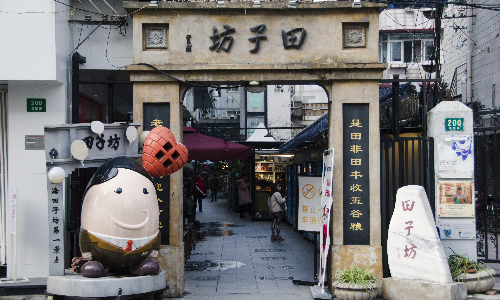
Today, we will drive west to Zhujiajiao Water Town for visiting. It is 49 kilometers away from Yu Garden and it will take about 1 hour to get there. Zhujiajiao is a typical ancient water town in the south of China with a history of more than 1,700 years. Nine long streets are stretching along the rivers in the town. Places of historical interest can be seen everywhere. Arriving here, you will have a relaxing wooden boat tour. It will take about 15 minutes to get to the heart of the town. During the boat tour, you can have a general impression of Zhujiajiao. After that, you will have detailed sightseeing. Among the 36 ancient stone bridges, there’s a five-hole stone arch bridge called Fangsheng Bridge or Setting-free Bridge. It is known as the First Bridge in Shanghai. According to legend, once Guanyin Bodhisattva (a Goddess in Chinese legend) passed by Zhujiajiao and saw a fisherman catching a golden fish. The fish was the incarnation of the little princess of the Dragon King (God of the sea in Chinese legend) of the East China Sea. The Bodhisattva then turned into a mortal and persuaded the fisherman to release the golden fish. The fisherman took her advice and released the fish. Guanyin Bodhisattva thought the fisherman was very kind. So, she took him as a disciple and brought him to heaven. Later, people built a bridge here and gave it the name Fangsheng Bridge, which means setting life free to show respect for life. During the sightseeing, you will have your lunch in the water town.
After visiting the water town, we will drive east for an hour (48 kilometers) back to the downtown area for the following sightseeing. The next destination is the Bund, which is a must-see attraction in this city. It is 1.5 kilometers long. Standing on the Bund are 52 classical buildings of different styles, which are known as Exotic Building Clusters. These buildings include Shanghai Club, Shanghai Pudong Development Bank, Peace Hotel, etc. Besides, you can also enjoy many buildings of local style, such as the Valentine’s Wall, the Public Park, and so on.
Walking northwest from the Bund for 8 minutes, you will come to Nanjing Road. It is a world-famous commercial district, known as the First Commercial Street in China. Many specialty shops are stationed here, including Laojiefu, a large silk and cloth store, and Hengdeli, a watch and glasses shop. Besides, if you are a food lover, you will enjoy yourself here. There are numerous delicious foods sold in time-honored stores, such as Sliced Roast Duck of Yanyun Tower, all kinds of pastries of Shendacheng, the meat-stuffed mooncake, and smoked fish of Laodafang, and so on.
That’s your today’s tour. You will be transferred back to the hotel safely.

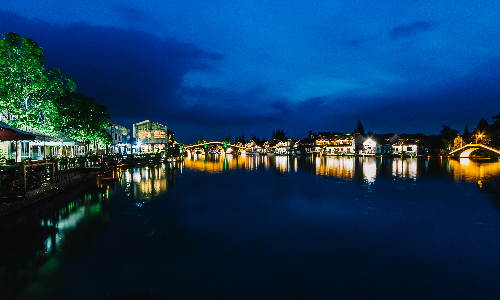
 Hangzhou
Hangzhou After breakfast, you need to check out and then will be taken to the railway station to take the estimated high-speed train G85 08:00/08:45 to Hangzhou. Your Hangzhou tour guide will warmly welcome your arrival.
The first destination in Hangzhou is West Lake. The West Lake Scenic Area is located in the west of Hangzhou city, with a total area of 49 square kilometers and a lake area of 6.38 square kilometers. During this tour, you will take a boat trip to appreciate the charming scenery of West Lake. West Lake has been also known as the “Jinniu Lake” since ancient times. Jinniu means the golden ox in Chinese. According to the legend, in the West Han Dynasty (202BC-8AD), there was a kind golden ox hiding at the bottom of West Lake. Whenever the lake dried up during a drought, the ox would emerge and spit out water to fill the lake for people to use. The local officials wanted to catch the ox to please the emperor, so they ordered people to drain the lake. When the lake was dry, they saw the golden ox. The officials rushed down to the lake to catch the ox. Suddenly, the golden ox roared and opened his mouth to spit water. Soon, officials were drowned by the water. From then on, no one dared to catch the ox. But the ox no longer appeared, and the West Lake no longer dried up. Later, people called the lake Jinniu Lake as a memory of that disappeared golden ox.
After lunch, you will visit Feilai Peak. It is a famous attraction in the West Lake scenic area. The peak is 1,424 meters high and full of lush ancient trees and deep caves. There are also numerous rocks of grotesque shapes, some like dragons, some like running elephants, some like lying tigers, all of which make the peak looks like a rock zoo. On the slopes of Feilai Peak, facing Lingyin Temple, there are more than 340 Buddhist grottoes carved after the Five Dynasties and Ten Kingdoms Period (902 - 979).
Facing Feilai Peak, Lingyin Temple was first built in the Eastern Jin Dynasty (317 - 420) and rebuilt at the end of the Qing Dynasty (1636 - 1912), covering an area of about 87,000 square meters. It is an ancient Buddhist temple in China, founded by a West Indian monk named Hui Li. Legend has it that when Hui Li came here, he found that Feilai Peak is the place where the reiki of immortals accumulated. Then he built a temple facing the peak, named Lingyin Temple, which means the reiki of immortals hiding. When visiting the temple, you will feel immersed in a deep Buddhist atmosphere.
To the west of West Lake scenic area lies Longjing Village. You will have the chance to visit Longjing Tea Plantation here. It is the main producing area of West Lake Longjing tea. If you want to learn about China’s tea culture, learning Longjing tea is an essential part. West Lake Longjing Tea has a history of more than 1,200 years. It became famous both at home and abroad in the Qing Dynasty. After the founding of the People’s Republic of China (1949), Longjing tea was listed as a national diplomatic gift tea. During today’s Chinese tea culture tour in the tea plantation, you will watch how to make Longjing tea. That would be a very interesting experience.
When today’s tour ends, the guide will take you back to the hotel.

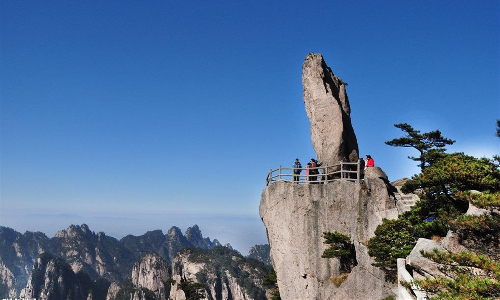
 Mount Wuyi
Mount Wuyi This morning, after breakfast you will be transferred to the Railway Station to take the estimated high-speed train G1653 09:04/10:54 to Nanping City. When you arrive, you will be welcomed by your tour guide and then be taken to go on your tour.
Today’s tour will start with visiting Mount Wuyi. Mount Wuyi scenic spot covers a total area of 999.75 square kilometers. Yunwo scenic spot, which means the place where clouds gather, is the center of the whole scenic spot, surrounded by many large rocks and peaks. On the early mornings of spring and winter, cloud and fog always float into this area, and then it got its name. In this area, Tianyou Peak is one of the main beauty spots. On the stone wall next to a stream at the top of the peak, there are nearly 100 precipice inscriptions of past dynasties. You will be surprised after seeing these inscriptions. Walking through a stone door, you will come into the Tea Cave. There is an interesting story about the origin of its name. A long time ago, an old man in Wuyi Mountain was injured in front of a cave while collecting medicinal herbs for sick villagers. He was in a coma for a long time. Luckily, an immortal saved him with some magic water made from tea leaves. The immortal gave him a tea tree and let him plant trees with its branches. The immortal also said the leaves could be used for disease treatment. Then the immortal left. The old man then planted the tea tree in front of the cave and picked up some leaves from the tree. Then he hurried back to the village and healed the sick villagers. When villagers got better, they followed the immortal’s instructions and thus got more tea trees. To commemorate the benevolence of the immortal to bring tea, people called the cave “Tea Cave”. You can ask your guide for more interesting information about Wuyi Mountain tea if you want.
After sightseeing, you will be escorted to the hotel.

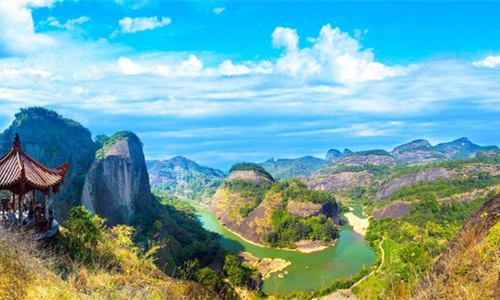
Today we will continue the Mount Wuyi tour. Dahongpao Scenic Area is located in the center of Mount Wuyi Scenic area. It is where Dahongpao Tea grows. Dahongpao Tea is a famous special tea in China. Legend has it that in ancient times, an empress was ill and could not recover for a long time. The crown prince, the son of the empress went to find medicinal herbs for her. Accidentally, the prince saved an old man who had fallen from a tree. After learning the news of the Queen's illness, the old man accompanied the Prince to Wuyi Mountain to pick tea leaves, because he heard that tea can cure all kinds of diseases. After drinking the tea water made from those leaves, the empress recovered miraculously. The emperor was so glad that he appointed the old man as the General of tree protection, and gave him a red robe, called Dahongpao in Chinese to protect the tea trees in winter. Later, those tea trees in Mount Wuyi were called Dahongpao.
Shuilian Cave is the largest cave in Mount Wuyi scenic area. Its height and width are over 100 meters respectively. The two springs that flow all year round in front of the cave pour down from the top of the rock more than a hundred meters high. Drops of water are falling in the wind, forming two hanging bead curtains. You will be surprised by what you see.
After lunch, we will visit Yixiantian scenic area. Yixiantian is the most magical cave in Mount Wuyi Scenic area. It is located at the southwest of Mount Wuyi and lies in a deep canyon. Walking into the cave and looking up, you will find there is a crack in the top of the rock like the cut of an ax. It is less than 0.3 meters wide and more than 100 meters long. The sun shines through the crack. It’s so beautiful and amazing.
Walking out of Yixiantian and continue going forward for hundreds of steps, you will see Tiger Roaring Rock. When the wind comes through the cave passing the rock, it makes a sound like tigers’ roaring. So, it was named Tiger Roaring Rock. You can hear the sound clearly here.
That’s the end of today’s tour. Your guide will take you back to the hotel.

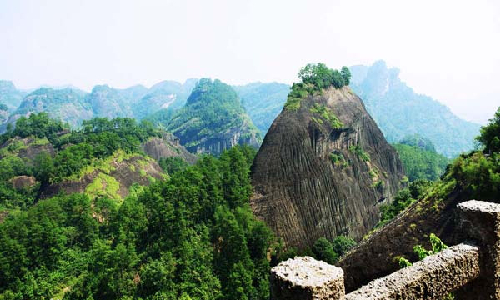
 Xiamen
Xiamen Today, you will take the estimated high-speed train G9881 10:03/13:35 to Xiamen. Upon your arrival, our local guide will pick you up at the railway station, and then you will start sightseeing.
First, you will visit along Huandao Road. Huandao Road is a strip scenic spot where you can enjoy the beauty of the seascape. The road is 43 kilometers long and 60 meters wide. You will pass by Baicheng city, Hu Li Shan Fortress, Xiamen International Conference and Exhibition Center, and many other major scenic spots along the road. The road is set up as part of the international Marathon track every year, so you can see many people running along the road for exercise, both the young and old.
Then you will go to Nanputuo Temple. The temple covers an area of 258,000 square meters. It was first built in the Tang Dynasty (618 - 907) but has been destroyed and rebuilt many times, so the whole temple buildings are still relatively new. The main buildings on the central axis are the Hall of Heavenly King, the Main Hall, Hall of Great Mercy, and the Sutra Pavilion. The Main Hall is the center of the temple. It is a two-story building with grey tiles and stone columns, covered with glazed tiles.
Behind the temple is Five Old Men Peaks at an altitude of 185 meters. It usually takes about an hour to reach the summit. The Five Old Men Peaks looked from a distance like five old men with white hair and beard looking out at the sea. Engraved on the slope behind the Sutra Pavilion are three characters which mean five old peaks.
After relaxing sightseeing, the tour guide will lead you back to the hotel for a rest.
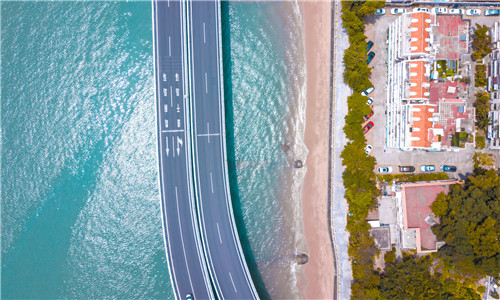
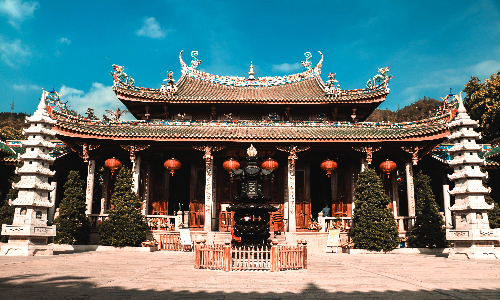
Today you will have a Nanjing Tulou tour. We will drive west for about 2 hours (144 kilometers) from the downtown area of Xiamen to get there. Nanjing Tulou is a kind of traditional residential building where Hakkas live together. Tulou buildings are usually three to five floors high. Each building can accommodate 200 to 700 people. The outer wall and inner wall of the buildings are concentric circles.
Tianluokeng Tulou Cluster is a small settlement of Hakka people whose family name is Huang. It is made up of five buildings of different shapes: one is square, one is elliptical, and the rest three are circular. Each building has only one gate as the entrance. Entering the gate, you can see the spacious patio. The buildings have complete living facilities. For hundreds of years, people in the five buildings, regardless of their generations or ages, lived in harmony. When visiting here, you can feel their happiness.
After lunch, you will visit Yuchang Building. It is the oldest circular Tulou building in Nanjing County. The biggest characteristic of this building is that some of its pillars lean to the left and right. It was first built in the early Ming Dynasty. As time goes by, the pillars of the cloister on the third and fourth floors lean to the clockwise while those of the fifth floor lean to the counterclockwise. It looked as if these pillars would fall with a crash if a gust of wind came. However, after its building, Yuchang Building has experienced so many earthquakes and stormy weather without collapsing. You will be surprised by this magical building.
Then, you will come to Taxia Village. It is a traditional Chinese village, covering an area of 5.68 square kilometers. Tulou buildings in this village were built along the river and all were made into different shapes, including square, round, oval, and rectangular.
After visiting the Nanjing Tulou, we will head to the Chengqi Building. It covers an area of 5,376.17 square meters. The three main buildings are arranged in concentric circles, with an ancestral hall standing in the center. The outermost building is four floors high with 72 rooms on each floor . The second ring has two floors with 40 rooms on each floor, while the third ring is a single floor with 32 rooms. Interestingly, because of the special structure, some people living here all their lives may never see each other.
When the Tulou tour ends, you will be transferred safely to the hotel in Xiamen.
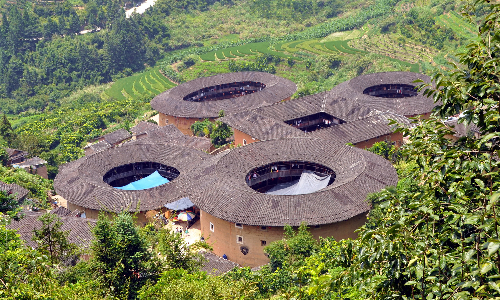
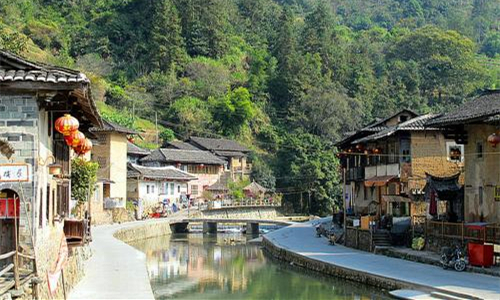
 Chaozhou
Chaozhou This morning, you will come to visit Gulangyu Island, a landmark in Xiamen. You will first be taken to the pier. Then you will take the ferry to the island. Gulangyu Island is the largest island in Xiamen. It covers an area of 1.91 square kilometers and has more than 20,000 people. In 2017, Gulangyu Island was listed as a World Heritage site. Sunlight Rock is the highest peak on Gulangyu Island. Standing at the gate of Sunlight Rock Scenic Area, you can see three cliff carvings carved in different periods on a large rock with 40-meter high. Entering the gate, you will see the Sunshine Rock Temple that has a history of more than 400 years. All of these will leave a deep impression on every visitor coming here.
At the foot of Sunlight Rock, there is Shuzhuang Garden. Built in 1913, it was originally the private villa of the famous local gentry Lin Erjia. It covers an area of 20,328 square meters. The whole garden is divided into two parts: the garden of the sea and the garden of the mountain. Walking out of the moon-shaped gate, you will find the sea right in front of you. You can ask your guide for more stories about this garden.
After lunch, you will be escorted to the railway station to take the estimated high-speed train G1601 15:59/17:20 to Chaozhou. Your guide will be waiting for you at the exit and then transfer you to the hotel to check in.


 Phoenix Village
Phoenix Village After breakfast, we will drive north for about 60 kilometers to get to Phoenix Mountains. It will take us around 1.5 hours. Here you will climb the mountains to visit local tea makers’ houses and their tea plantations. On the way of climbing up, you can appreciate the beautiful scenery of tea groves all over the mountains. That is undoubtedly amazing. Wudong Mountain is the second highest peak of Phoenix Mountain. It is the birthplace of Phoenix Dan Cong Tea. Wudong Mountain is rich in minerals because of its unique volcanic topography, which is beneficial for the growth of tea trees. Therefore, you will see many ancient tea trees with strong and deep roots here.
In the afternoon, the guide will take you to Phoenix Village. It lies in the southeast of the mountain. We will drive for 13 kilometers in about 18 minutes. The Phoenix Dan Cong Tea Museum (closed on Mondays) in this village is well worth visiting. Here you can visit the exhibition hall of Dan Cong Tea culture, acquire more about tea knowledge, and experience making a cup of tea on your own. Phoenix Dan Cong Tea is produced in Phoenix Village, with a history of more than 900 years. The tea leaves of the Phenix Dan Cong Tea are thick strips with a brown sheen. The tea tastes fresh and its fragrance can last for a long time.
After finishing sightseeing, you will be transferred to the hotel in Phoenix Village for a rest.
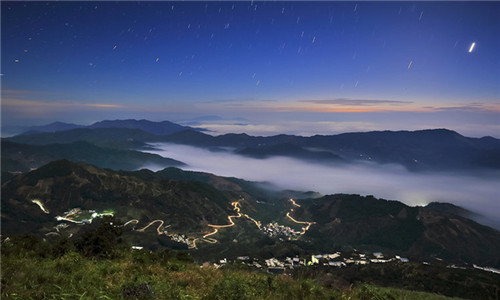
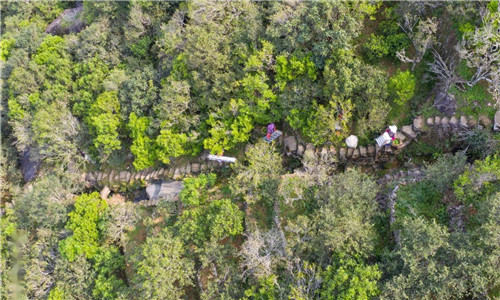
 Chaozhou
Chaozhou In the morning, we will drive you back to Chaozhou after breakfast. It is about 39 kilometers north of Phoenix Village and you will spend one hour getting there.
First, we will arrange a visit to a famous teapot maker’s studio. You can get some knowledge about making teapots here. Then, you can taste some delicious food in Stone Arches Pedestrian Street. Hand-made beef meatball is the representative of Chaozhou snacks. With a history of nearly 100 years, the hand-made beef meatballs can be served as a snack as well as a soup dish for banquets. Besides, you can also taste other local snacks including the poi cake, Yamunian (glutinous rice dumplings stuffed with mung beans, red beans, or poi), and so on.
After lunch, you will go to visit Guangji Bridge. This bridge is first built in the Southern Song Dynasty (1127 - 1279). Standing here, you can see the wide-open sky and the vast river, which will make you relaxed.
The next destination is Kaiyuan Buddhist Temple. It was first built in the Tang Dynasty and fully repaired in 1982. It is a place mainly for emperors and local officials to preach the decrees of the government. The main buildings include Hall of Great Mercy and the Thai Buddha Hall. If you want to know some stories about this temple, you can ask your guide for answers.
You will return to the hotel and rest after sightseeing.
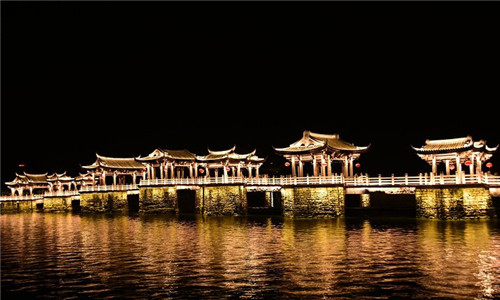
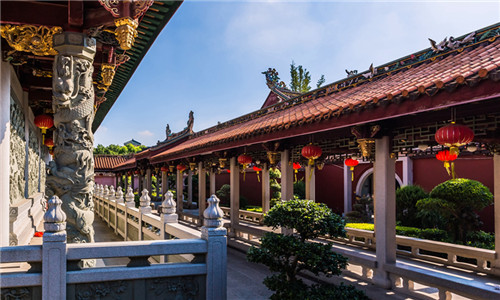
 Guangzhou
Guangzhou This morning, you will be escorted to the railway station to take the estimated train D7547 07:14/10:11 to Guangzhou City. Upon your arrival at Guangzhoudong Railway Station, your guide will pick you up and take you to go on the tour.
Chen Family Temple is the first scenic spot you will visit. In the Qing Dynasty, it was built with contributions from Chen clansman all over Guangdong province. At that time, Chen Family Temple mainly acted as a temporary residence for the descendants of Chen’s clan to go to the provincial capital to prepare for the imperial examination, to be appointed as a government officer, to pay taxes, and to deal with other affairs. Today, it is a museum with more than 20,000 pieces of precious cultural relics and modern craftsmanship products, including Shiwan Pottery, ivory carvings, Guangdong embroidery, wood carvings, etc.
Next, we will drive to Xiguan Old Houses. In the late Qing Dynasty, rich families and merchants built these houses. It is a traditional form of dwelling in Guangzhou. Generally, each house covers an area of 400 square meters. The interior is usually decorated with woodcut screens and Manchurian windows. You will also see a lot of expensive redwood furniture in the house.
In the afternoon, the guide will take you to the last destination, Shamian Island. It is a unique tourist attraction in Guangzhou, with an area of just 0.3 square kilometers. There are more than 150 ancient European buildings of European style on the island. Some are beautiful and elegant, some are dynamic, some are majestic, and some are simple with smooth lines. With a lot of ancient trees around, these buildings look very charming.
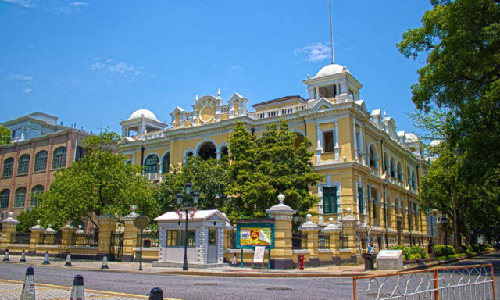

The 13 days China Green Tea Tour is coming to an end. You will be transferred safely to the airport for your back flight. We sincerely wish you a wonderful trip home!
Author: Yang Ying
Proofreader: Lexie
| City | Five Star hotel list | Four Star hotel list |
|---|---|---|
| Shanghai | Ocean Hotel Shanghai | Ambassador Hotel |
| Hangzhou | Landison Plaza Hotel | Best Western Plus Meiyuan Hotel Hangzhou |
| Nanping | Ramada Plaza by Wyndham Nanping | Ramada Plaza by Wyndham Nanping |
| Xiamen | Jingmin Hotel Central Xiamen | Xiamen Huaqiao Hotel |
| Chaozhou | Vienna Hotel Chaozhou Plaza Branch | Vienna Hotel Chaozhou Plaza Branch |
| Phoenix Village | Guest House | Guest House |
| Guangzhou | Baiyun Hotel | Ocean Hotel |
 |
![]() About your child or infant, please contact us for a discounted price.
About your child or infant, please contact us for a discounted price.



We started with a few days in Beijing & ended in Shanghai, from where we visited the Forbidden City and Great Wall. In between we visited Terra Cotta Warriors Museum, Panda Base, Shanghai Disneyland.

We had a wonderful holiday in China which will remain long in the memory. China is a breathtakingly beautiful country full of splendid temples and palaces, mountains and rivers, peaceful rural scenes and bustling shopping streets.
 QUICK ENQUIRY
QUICK ENQUIRY